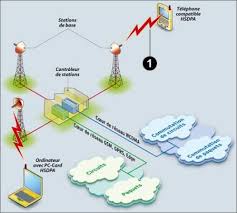
- HSPA - High Speed Packet Access
- HSDPA - High Speed Download Packet Access
- HSDPA+ - Enhanced HSDPA
After the initial installation of 3G networks, there is still demand for faster 3h networking. The Mobile Network Operators used the enhancement to 3G to try out some developments that were to be built into the new 4G network. The initial enhancement for 3G was HSPA, which was formed of two aspects, HSDPA and HSUPA. These enhancements add to the downlink and uplink. However for most it is the downlink that was in need of development hence the usual implementation is HSDPA.
There are 3 significant factors included in HSDPA.
The first factor is the potential use of more than one download link for a particular transmission to a single user. If a user had access to 2 channels then there was potentially for doubling the download speed. To achieve MIMO technology needed to be employed. The phones would need more than one aerial installed for the mobile to receive multiple channels.
The modulation system was increased to use 16QAM. But also AMC (Adaptive Modulation and Coding) was introduced. This allowed mobiles with a strong system could use 16QAM or indeed 64QAM but mobiles with poorer signals would use QPSK. All modulation schemes would be understood.
The final factor is HARQ - highspeed automatic retransmit request
The speed of HSDPA was around 3.2Mbps, with a theoreyical limit of 7.6Mbps. At the time of introduction (2006/7) the standard home broadband speed was 1Mbps. Hence HSDPA could complete with home braodband for the first time
HSDPA+ was an enhanced version of HSDPA introduced later. Claimed to deliver similar speeds as 4G. At the time of the the introduction of 4G it had a theoreticl speed of 25Mbps whereas the theoretical limit of HSDPA+ is 21Mbps. So the speeds are similar. THREE used this fact to push their HSDPA+ network. The HSDPA+ speeds on THREE were around the same as the other 4G speeds at the time of 4G introduction.
HSDPA+ key technologies :
- 64QAM
- MIMO
- Dual cell transmission
- Better balance between packet data and cell switching
*u* ©mobilephonetechnology.co.uk all rights reserved 2017- 2025



